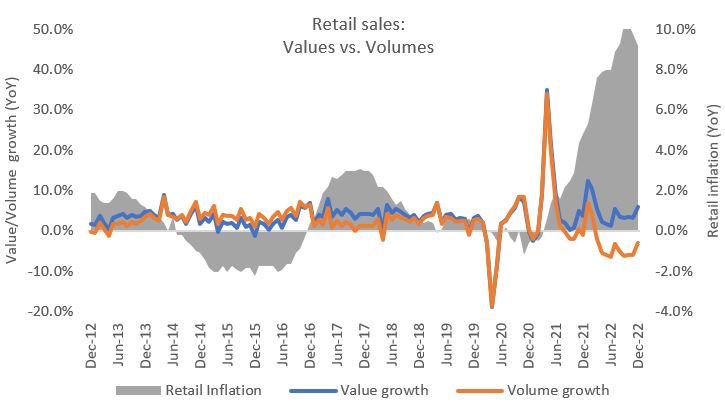ONS Retail Sales December 2022
- Retail sales (value, non-seasonally adjusted, exc. fuel) rose by 6.0% year-on-year (YoY) in December, but continued to lag double-digit inflation according to the latest ONS data.
- In volume terms (non-seasonally adjusted, exc. fuel), retail sales declined by 2.9% YoY in December, against a weak 0.9% decline a year earlier, continuing consecutive volumes declines since March 2022.
- The three-month-on-three-month volume rate saw a decline of 1.2% in the quarter to December (volume, seasonally adjusted).
Retail sales value and volume growth has detached

Source: ONS, Retail Economics analysis
Note: all retail sales figures provided below are non-seasonally adjusted, excluding Fuel, unless stated otherwise.
Food and non-food
- Food sales values stepped up by 8.4% YoY (versus 4.7% last year), making the strongest rate since the shock of ‘stay at home’ orders in March 2020. However, after accounting for accelerating double-digit food inflation, food volumes declined by 3.9% YoY in the month.
- Clothing sales soared 19.1% YoY in December, against a 13.3% rise a year earlier. Volumes rose by a strong 10.4% in the month, with the quantity of clothing sold broadly at typical pre-pandemic levels for December.
- Freezing temperatures drove demand for boots in December and supported Footwear & Leather Goods sales values soaring 29.3% YoY, with volumes up 24.7% in the month to well above typical pre-pandemic levels.
- Furniture and Lighting also saw sales volumes rocket 21.3% in December, but this came against weak comparatives, with volumes declining 19.7% in the previous year.
Online
- Online sales values declined throughout 2022 and slumped 7.5% YoY in December.
- All major online categories recorded a decline in the month, with Household Goods a notable exception as ecommerce sales rose 7.9% in December.
- Non-store retailing (a proxy for pureplay retailers) saw sales decline by 9.3% YoY in December.
- The proportion of retail sales made online slipped to 26.6% in December – down from 30.5% a year earlier, but ahead of a pre-pandemic peak of 21.6% in November 2019.
Retail sales price deflator
- The retail sales deflator (a measure of inflation specific to retail) continued to soften but remains historically high. The deflator stepped up by 9.2% YoY in December when excluding fuel, and by 9.4% when including fuel.
- The implied price deflator among food stores rose by 12.8% YoY in December, implying food prices faced double-digit rises through H2 2022. Among non-food stores, the price deflator rose by 7.0% in the month.
Back to Retail Economic News